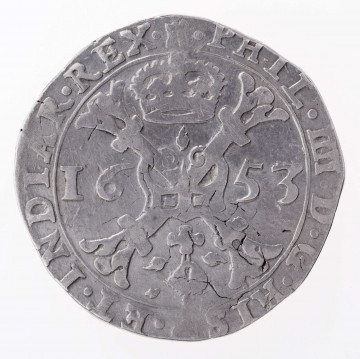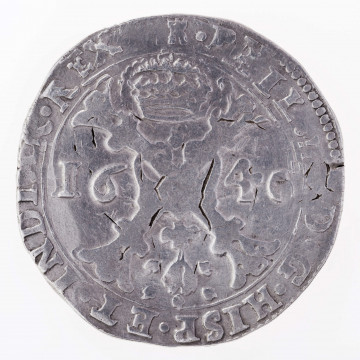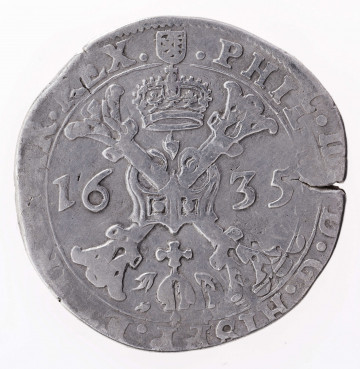
Patagon of Philip IV
1653
National Museum in Lublin
Part of the collection: Treasure of the 16th–17th c. coins from Józefów on Vistula
The progressive economic development of Europe in the 15th and 16th centuries and the increase in trade connecting the Old Continent with the Americas and Asia at the time of the great geographic discoveries, created a need for money with a high purchasing power. The scarcity of gold meant that this need could only be met to a small extent by the issue of gold ducats and guilders. Due to the discovery of silver deposits on the continent and the exploitation of its vast resources in the Spanish colonies of South America, this role fell to silver coins. Originally, they were to be equal in value to gold ducat issues.
The first such coins were struck in Tirol (1486) and Saxony (1500). A mass issue of silver ducats, using their own metal resources, was undertaken in 1518 by Count Stephan in the Schlick district of Bohemian Ore Mountains, at the mint located in Sankt Joachimsthal. The coins coming out of Sankt Joachimsthal – hence called thalers – spread in the central part of Europe. Within a few decades they were adopted by the monetary systems of many countries, in which they functioned under various names. In England they were silver crowns, in Turkey ‘gurus’, and the Spanish Netherlands had ‘patagons’ introduced in 1612 and issued until the early 18th century.
‘Patagons’ are characterised by an oblique cross with a crown between its arms and the Order of the Golden Fleece hung at the bottom on a Burgundian cross. The circumferential inscription – continued on the reverse side – speaks of the person of the issuer and shows his abbreviated monarchical title. On this coin it reads, in translation, ‘Philip IV by God's grace King of Spain and India, Archduke of Austria, Duke of Burgundy and Brabant’. On the reverse there is a crowned, multi-poly heraldic shield of Spain with coats of arms of the lands, principalities and families, surrounded by a chain with the Order of the Golden Fleece, whose grand masters were Spanish kings.
The piece in question is part of a hoard of 83 thaler coins, hidden after 1708 in Józefów in the Biłgoraj region. More than a half of it consists of Dutch ‘patagons’, which were brought to our lands in abundance by way of trade, especially in the second half of the 17th and early 18th centuries. The Brabant issues of Philip IV were predominant among them.
The purchasing power of the thaler in Poland at the turn of the 17th and 18th centuries was equivalent to the cost of feeding a man for four weeks.
Tomasz Markiewicz
Author / creator
Dimensions
cały obiekt: width: 40,9 mm, diameter: 43,1 mm
Object type
numismatic
Technique
stamp minting
Material
silver
Creation time / dating
Creation / finding place
Owner
The National Museum in Lublin
Identification number
Location / status

1653
National Museum in Lublin

1646
National Museum in Lublin

1635
National Museum in Lublin
DISCOVER this TOPIC
Castle Museum in Łańcut
DISCOVER this PATH
Educational path